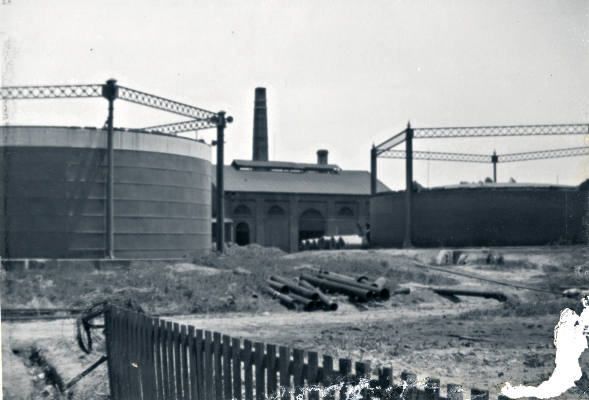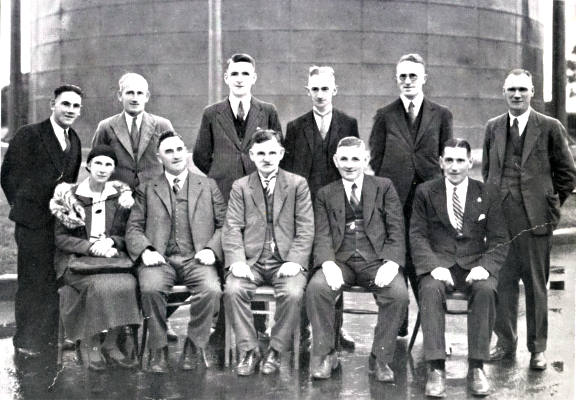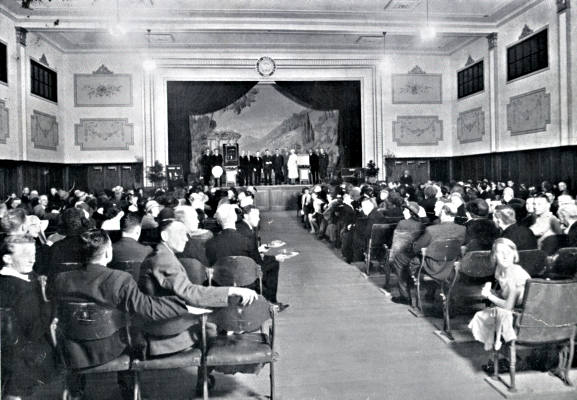The Mentone Gas Company

Mentone Gas Works, Brindisi Street, 1928. Courtesy Mordialloc and District Historical Society.
With the development of Mentone in the early 1880s by Matthew Henry Davies came the formation of several companies to provide the facilities and services desired by residents and needed to attract potential land purchasers. The Mentone Coffee Palace, the Mentone Hotel and the Mentone Baths were built by such companies. Another company was the Mentone, Cheltenham and Mordialloc Gas Company.
The gas company was formed in 1886 with a capital of £20,000. [1] By May of 1888 the acting manager George Cornell advertised that the registry office of the company had been established on the work’s site in Brindisi Street, Mentone. Later that year, in December, the construction engineer, Stephen Hutchinson, informed the public that the distribution system was in place and the remainder of the gas mains on site would soon be installed.
The facilities matched almost all the gasworks established through country Victoria and had a capacity of 40,000 cubic feet of gas, together with the potential for expansion to double this amount with only minimal additional investment. The initial cost was £19,300, almost triple the average construction costs of country gas facilities, but the Mentone facilities were claimed to be of the highest quality. [2]
One hundred and twenty guests celebrated the opening of the gasworks on March 12, 1889 at a dinner at the Mentone Coffee Palace. It was chaired by Matthew Davies, and attended by his brother Joseph Davies, T B Muntz, John Moodie and George Cornell, the latter two gentlemen being directors of the company. [3] All were caught in the financial crash in the next few years, a time when the company experienced financial difficulties.
In July 1899 officers of the company approached the Shire of Moorabbin with the goal of selling the company. [4] Three months later the secretary of the Council was authorised to make an offer of £2800 subject to it being approved by ratepayers. [5] But the directors of the company wanted more. After J S Butters, acting on behalf of the company, set a price of £3000 the Council made a second offer of £2900 for plant, buildings and machinery. [6] The deal was eventually struck with the Council arranging a loan of £3400, sufficient to purchase the works and to make necessary repairs and improvements to its operation. Repayment of the loan was to be spread over 30 years with an interest bill of four percent each year. [7]
Almost twenty years later, in 1918, the Council itself was exploring the possibility of selling the gas works. A report to Council from the gas committee recommended the sale because of increasing competition from the Brighton Gas Company which was extending its mains to Black Rock, the strong possibility of electric light being supplied to the district, the fact that the unit cost of production was higher than unit price achieved through sales, and the problem of having the enterprise supervised by a body of unpaid men. Councillors didn’t have the time to adequately supervise the operation and as a result the manager and his men had done exactly as they liked, the report claimed. The time, the authors of the report suggested, had come for a change. [8]
The Councillors supporting the retention of the gas works argued the company served over 1400 consumers and while the desirable profit had not eventuated the ‘almighty dollar’ should not be the sole consideration where a public utility was involved. When large expenditures are incurred for capital works the organization must be allowed time to redeem the situation, they pointed out. The liabilities at that time were noted as being £11,232 but the assets were valued at £14,797. While these Councillors acknowledged that at times the quality of gas was not perfect they noted in almost in all cases of complaint the problem was due to the householders own pipes rather than the quality of the gas delivered. [9]
Supporting the sale of the company, Cr Rogers said the 1917 balance sheet showed a loss and insufficient provision had been made for the depreciation of plant. His colleague from Mentone, Cr Scudds, said he was strongly opposed to giving over of any public utility to a private company and went on to explain that the mismatch between cost of production and price charged for the gas occurred only for a short time when there had been a tremendous increase in the price of coal. For him, gas was a far better illuminant than electricity. “Gas was far ahead,” he said. [10]
When the Council came to vote on the committee’s recommendation of sale, the votes for and against were equal and the president contended the matter was far too important for him to use his casting vote. He deferred the matter for a fortnight.[11] At the next meeting of Council the president, Cr White, indicated he proposed using his casting vote in favour of sale. This brought an objection from Cr Scudds who drew attention to the Local Government Act where it said the casting vote must be used on the occasion the issue was discussed and voted upon, and not at a subsequent meeting. The president had left it too late! However the impasse was removed when Cr Brownfield informed his colleagues he had changed his mind. He no longer supported the sale. Instead of selling the company, the Council resolved to explore alternative forms of management. [12] Mr Michell, the engineer of the Brighton Gas Company, was asked to furnish a report on the Mentone operation at a cost not to exceed £20. [13]
Consumer, writing in Seaside News, railed against the failure of the Council to provide information about the operation of the gasworks and reveal its financial accounts. He believed this was knowledge the ratepayers were entitled to have. He suggested good buyers for such a company were unlikely to be plentiful and wondered what hundreds of consumers would think when their appliances became worthless. They would either have to revert to kerosene or be saddled with the cost of electric light installations, both unattractive options in his view. Every endeavour he pleaded should be made to run the gasworks in a business like way. [14] The following week Hugh Smart of Mentone posed the question; “If private enterprise can make the gasworks pay why cannot the Council succeed?” [15]
Five months later correspondents to the local paper were complaining about an action of the gas company aimed at improving its financial position. The proposal was to impose a charge of one shilling per month on the provision of meters where less than 1000 feet of gas was used. Ratepayer argued this was simply putting a heavy tax on the small householder and allowing the more affluent to go free. He preferred the option of slightly increasing the price of gas so that everyone shared the burden. [16] Objector was stronger in his protest. He declared it tyrannical and against all sense of fairness. In fact he called it robbery. [17]
Ratepayer was again writing in October protesting to the local newspaper against the Shire Council’s proposal to offer the Black Rock portion of its gas main network to the Brighton Gas Company. He saw it as the most valuable part of the network. The only justification advanced by the Council for this action, he claimed, was the fact that Black Rock was no longer part of the Shire of Moorabbin, for in February 1917 a large portion of the Shire had been excised to form the Borough of Sandringham. [18]
Influential individuals in Mentone, Mordialloc and Parkdale were also seeking their independence from Moorabbin and in May of 1920 it was granted. [19] After the new Borough of Mentone and Mordialloc was gazetted and the first Councillors elected, one of the earliest issues they had to address was the gasworks, owned by the Shire of Moorabbin but located in the new Borough.
The Moorabbin Councillors were reluctant to give up a facility in which they had made a substantial capital investment and which served many of the Shire’s residents. On the other hand the new councillors of the Borough thought it rightly theirs. Agreement could not be reached so the Minister of Public Works was asked to act as arbitrator in determining the future ownership of the enterprise. In a deputation to the minister the Mayor of Mordialloc, Cr Rogers, pointed out that ninety per cent of the gas consumers were residents of the Borough and the works were in his municipality, therefore he had difficulty in seeing how Moorabbin could make any claim for compensation. Cr Greenwood of Moorabbin maintained that an attempt had been made to throw dust in the eyes of the Minister by the ninety per cent statement and supported a suggestion that the whole matter should be referred back to the councils for further negotiations. The Minister said he hoped the parties would reach a mutually agreed position, one that did not require his intervention, but he reserved the right to make a decision if they could not arrive at a settlement. [20]
Agreement was reached after further negotiation, and the Mentone Gas Works became the responsibility of the Borough of Mentone and Mordialloc. There was to be no alteration in the management and no new financial responsibilities to be entered into pending the completion of the transfer of responsibility. Most importantly to Cheltenham residents, no differentiation was to be made between consumers in the Borough and the present and prospective ones in the Shire regarding pricing. [21] After the completion of the agreement, and for some time later, it was suggested the Borough had acquired “a very doubtful asset, buildings quite out of date, plant obsolete, and leaky mains everywhere, and a source of worry and anxiety to all concerned.” [22]
On May 5, 1926 what was formerly a Borough and then a Town, was declared a City and the following year the Mordialloc Council was confident in announcing a phenomenal improvement in the situation of the gas works. It was claimed that the efficiency of the whole operation under the direction of the manager, W E Stevens, had improved considerably. Four miles of mains and five miles of service pipes had been laid for new consumers, the latest appliances for gas purification had been erected, and plans had been made to enlarge the carbonising plant. [23]
The manager’s report for 1934 revealed that a gross profit of £220 on operations for the month of March had been made, and the amount of gas produced had increased, although he noted there had been a fall in sales. He also informed the gas committee of management that repairs would have to be made to the retorts to maintain their efficiency and one of the gas holders would need to be overhauled within the next two years. Provision needed to be made in future budgets to allow this work to be completed, he advised.

Committee of the Mentone Gas Works 1934. Back Row: H Blanche (cadet), Cr J Blanche, A Crick, E R Bearup, H T Craig, W Rust. Front Row: Ex Cr May T Robertson, Cr H Edwards, Cr J H McBean (Chairman) Hon F Groves, E C Owbridge (Town Clerk).
Mention was also made of a problem with the slot meters. Slot meters controlled the delivery of gas to the householder. A coin had to be placed in the meter which enabled the householder to turn a screw to allow the flow of gas. At regular intervals officers or meter readers from the gas company would visit the home and remove the coins for banking. The problem referred to by the manager was that some meters were being broken open and the coins taken. For example, during the month of March three slot meters had been attacked and ten shillings and five pence stolen. Cr Herbert thought the answer to this problem was for the meter readers to note the number of vacant houses and to give this information to the police who would then be asked to keep a watchful eye on the premises and to apprehend offenders attacking the Council’s slot meters. [24]
By the 1930s competition from electricity put some pressure on the gas industry, but while electricity was being increasingly used for lighting it was found that people preferred to maintain their gas connections for heating and cooking. Given this situation the gas committee established a show room at the works in Brindisi Street but quickly found this was inadequate to meet the demand. As a consequence new commodious showrooms associated with the City Hall and Council Chambers were built where appliances could be displayed Cr McBean, chairman of the gasworks management committee, at the opening of the new showrooms said, “The housewife would now have everything at her command, every known appliance and gas of a superb quality”. After their inspection of the show rooms he invited them to move into the new City Hall for a cooking demonstration. [25]
Accompanied by community singing, close to a thousand people witnessed Nancy Burrows demonstrate cooking and bottling of fruit. On stage were two of the very latest gas appliances, New World Stoves, in which roast beef and potatoes, Yorkshire pudding, tomatoes, green peas, apple pie and baked custard were cooked. Whiting was also steamed. At the end of an hour and a quarter the whole dinner was revealed perfectly cooked. The fruit that was bottled included cherries, green gooseberries and apricots. At the end of the evening all the food was sold by Dutch auction and the proceeds given to the Ladies’ Benevolent Society. [26]

Gas Cooking Demonstration at Opening of Gas Show Rooms, Mentone.
The 1940s saw the gas industry under pressure because of coal shortages and in 1950 the Brighton Gas Company and the Metropolitan Gas Company joined with the State Government to form the Gas and Fuel Corporation of Victoria. [27] In 1954 the new corporation purchased the Mentone gasworks from the Mordialloc Council for £140,000. Speaking in the State parliament to the Bill authorising the purchase, the Minister of Public Works, Mr Merrifield, foreshadowed the closure of the enterprise. Over the previous few years losses of over £30,000 had been accumulated and the plant needed a great deal of new investment to bring it up to the standards necessary if it was to provide a satisfactory service. The gas works had become a burden on the municipality. The Mordialloc News welcomed the decision as they saw the sale bringing relief to the ever growing financial problems of the Council, a strengthening of its financial position and the removal of a ghastly eyesore from the centre of Mentone. [28]
The capital assets of the works were given a book value of £127,000 with the Corporation paying a deposit of £14,000 on the price of £140,000. Half yearly payments of £7000 were to follow with interest at the rate of 4 per cent. The Corporation also took over book debts and stocks. The Council expressed its satisfaction with the arrangements and by December 16, 1962 the transfer of the title to the property to the Corporation was complete. [29]
By April 1954 the Mentone operation ceased and the gas needs of its customers were supplied from the Gas and Fuel Corporation’s efficient and modern plant at Highett. Later and after the retorts, gas holders and buildings on the Brindisi property were demolished the title to the land returned to the control of the Mordialloc Council. [30] It was there that the Council built Corben House to provide supported accommodation for the elderly. [31]

Corben House, Brindisi Street, Mentone, 1982. Courtesy Leader Collection.
Footnotes
- Mordialloc See our City, Standard Newspapers, 1926.
- Cheltenham Leader, March 16, 1889.
- Cheltenham Leader, March 16, 1889.
- Shire of Moorabbin, Minute Book 10, July 17, 1899.
- Shire of Moorabbin, Minute Book, October 16, 1899.
- Shire of Moorabbin, Minute Book November 20, 1899.
- Shire of Moorabbin, Minutes Book December 4, 1899.
- Seaside News, February 23, 1918.
- Seaside News February 23, 1918.
- Seaside News, February 23, 1918.
- For : Crs White, Rogers, Davie, Brownfield, Porter and Small. Against: Crs Fairbank, McKittrick, Reynolds, Scudds, Marriott and Anderson.
- Seaside News, March 9, 1918; Shire of Moorabbin Minute Book, March 4, 1918.
- Shire of Moorabbin, Minute Book, March 18, 1918.
- Seaside News, March 2, 1918.
- Seaside News, March 9, 1918.
- Seaside News, August 17, 1918.
- Seaside News, August 10, 1918.
- Glass, M., Sandringham Breaks with Moorabbin, Article 35, http://localhistory.kingston.vic.gov.au
- Gamble, L., Battle for Local Government: The Severance of Mordialloc from Moorabbin, Article 253, http://localhistory.Kingston.vic.gov.au
- Moorabbin News, March 18, 1922.
- Moorabbin News, April 8, 1922.
- Souvenir: Official Opening of New City Hall, Mentone, 1934, page 17.
- Mordialloc See our City, 1926.
- Moorabbin News, April 14, 1934.
- Mordialloc News, December 23, 1933.
- Mordialloc News, December 23, 1933.
- Proudley, Ray, Circle of Influence: A History of the Gas Industry in Victoria. p334.
- Mordialloc News, January 7, 1954.
- Certificate of Title.
- October 20, 1976, Land Title.
- Corben House was opened in July 19, 1978 by Bill Burns, Federal Member for Isaacs with the Mayor of Mordialloc, Cr Jack Davidson.
